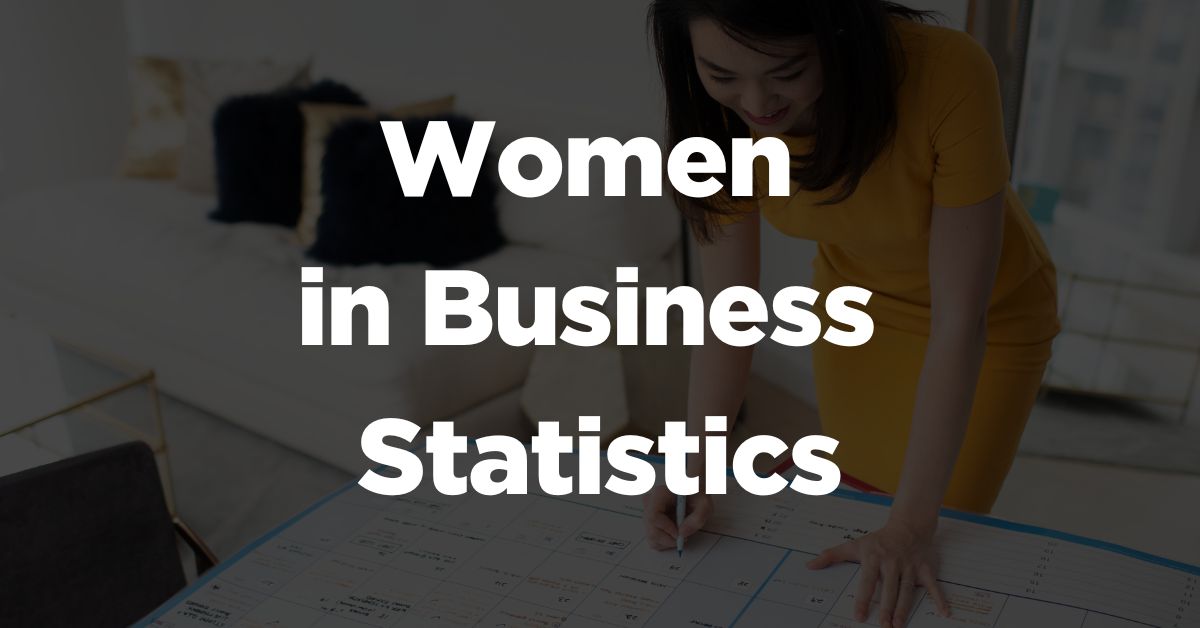Are you looking for the most recent women in business statistics?
You’ll learn how:
- Many businesses are owned by women
- Much VC funding women get
- Profitable women-led businesses are
- And much more!
Ready? Let’s dive in.
The top women in business statistics of 2024
- 42% of all U.S. businesses are owned by women
- Women-owned businesses have grown 114% in the last two decades
- Startups with all-women teams only received 1.9% of venture capital funding
- About half of all startups in the U.S. are founded by women
- One-third of businesses worldwide are owned by women
- Businesses with gender diverse executive teams are 25% more likely to have above average profitability
Global women in business statistics
1. Globally, one in three businesses has woman among the principal owners
(World Bank)
Some may find it surprising to learn that roughly one-third of principal owners of all businesses are female. To an extent, this female business ownership is proportional to a country’s income level. One in 4 businesses have female owners in low-income countries. Whereas, in the middle-and high-income countries, female entrepreneurship participation is higher, between 36% and 37%, respectively.
2. Only 10% of the global cross-company founders listed on Crunchbase are women
(Bright Data/Business Wire)
Of the total 8,800 global companies listed on Crunchbase, <900 (10%) was founded/owned by women. Focusing on businesses based in the United States, 11% of 5,379 listed companies are founded/owned by women. For UK-based companies, 8% of 532 listed companies are founded/owned by women.
3. The share of women hired into leadership roles has increased by 3.6% in the last 6 years
(World Economic Forum)
Share of women in leadership has witnessed growth over time. Increased number of women are being hired into leadership positions. The share of women hired into leadership increased from 33.3% in 2016 to 36.9% in 2022. The global gender party for senior and leadership roles recorded the highest ever score of 42.7% in 2022.
U.S. women in business statistics
4. In America, the number of women-owned businesses has increased 114%
(Inc)
Women start approximately 849 new businesses every single day in the United States and this number is increasing. Over the past two decades, the amount of women-owned firms has increased 114%.
5. 42% of all U.S. businesses are owned by women
(WBENC)
According to WBENC, a group of over 400 of the nation’s largest and most successful corporations, there are 13 million women-owned businesses in the U.S.—and counting. This represents 42% of all American businesses. However, WBENC notes there is significant disparity in the revenue and capital of women-owned businesses and others.
6. Women-led firms grew by 16.7% in 7 years
(National Women’s Business Council)
Between 2012 and 2019, businesses owned by US-based women grew by 16.7% in comparison to 5.2% for male-owned businesses. Women-owned businesses employed around 11 million workers and during the same 7-year range, their workforce grew by 28%.
7. The women’s Total Entrepreneurial Activity (TEA) rate in the U.S. increased to 15.2% in 2021 from 13.6% in 2020
(Global Entrepreneurship Monitor – Women’s Entrepreneurship Report 2022)
The TEA rate, or total early-stage entrepreneurial activity, for women in the United States increased by 1.6% during 2020-21 reaching 15.2%, well above the global average of 10.4%. There exists a gender gap with 0.85 female-male ratio due to less active women than men in the United States.
8. Almost 15% of U.S. women in business reported entrepreneurial intentions in 2021
(Global Entrepreneurship Monitor – Women’s Entrepreneurship Report 2022)
Approximately 14.5% of women in the United States reported to be interested in entrepreneurship in 2021. This figure is below the global average for women of 17.3%. However, for early-stage business, the activity rate of women in the U.S. was 5.3%, above the global average of 4.1%.
9. 37% of women investors are likely to invest in startups to their mitigate investment risks
(National Women’s Business Council)
More than one-third of female investors reported that they are more likely to invest in startups to diversify their portfolios and mitigate investment risks. This 37% of women compares to just 18% male investors’ willingness to invest in startups.
What percentage of entrepreneurs are female?
10. Less advanced and lower income countries have an average of 38% women business ownerships
(Mastercard Index of Women Entrepreneurs)
Women in less advanced and low-income countries including Botswana, Uganda, Ghana, and Malawi surpass their global peers with a higher women in business ownership rate of 38%. Meanwhile, women from high-income countries, like the United States, Portugal, New Zealand, Australia, and Spain, maintain a strong women’s business ownership rate ranging from 30-36% in the top 10 positions worldwide.
11. Lower-income countries have the highest participation (55.6%) of young female entrepreneurs
(Global Entrepreneurship Monitor – Women’s Entrepreneurship Report 2022)
According to this study, “young” female entrepreneurs were aged 18-34 years old. In the lower-income countries, this younger segment made up a majority 56% of female entrepreneurs. In upper-middle income countries, this segment was approximately 50% and in higher-income countries, it was just 43%. Young women entrepreneurs have attained parity with men, but for the age group of 55-64, it was below.
12. Globally, half of all women entrepreneurs work in the wholesale or retail verticals
(Global Entrepreneurship Monitor – Women’s Entrepreneurship Report 2022)
Almost 50% of the women entrepreneurs worldwide are involved in the wholesale/retail sector. Around 20% of women entrepreneurs can be found in the Health, Government, Education and Social services sector. Meanwhile, only 2.7% of women start their business in the ICT (Information, computer & technology) vertical, which is known for generating huge revenues and margins.
13. One in three women entrepreneurs are found in “traditional female sectors”
(World Bank)
Globally, an average of more than 30% of women entrepreneurs work within traditionally female sectors (63% in the African region). Factors such as social norms, childcare, additional family responsibilities, household work, and safety are impacting the participation of more women entrepreneurs in formal or larger sectors.
Women-founded startup statistics
14. Half of the startups in the U.S. were created by women founders in 2021
(Gusto Survey of Business)
According to a survey conducted by Gusto, in 2021, women represented 49% of startups in the U.S. This figure is up from 28% just two years earlier in 2019. Why? Experts believe the pandemic in 2020 has driven more women to create small startups, resulting in this 21% growth between 2019 and 2021.
15. Globally, one in 5 startups had at least one women founder in 2019
(Statista)
The share of startups led by at least one female founder has doubled from 10% in 2009 to 20% in 2019. This rapid growth carries over to unicorn startups, too. In 2019, 21 new unicorns reported having women founders, compared to just 4 in the year 2013. This translates to a growth of more than 400% between 2013 and 2019.
16. 15% of the unicorns that went public in 2021 had at least one female founder or co-founder
(Crunchbase)
In 2021, out of 124 unicorns that went public, 19 had at least one female co-founder. Of this small group of 19, 7 had a female CEO. In the same year, 83 out of the total unicorns that were added to the list had at least one female founder.
How many women are in business compared to men?
17. Women entrepreneurs grew by 48%, outpacing male counterparts by more than 20% in America
(Incfile)
Incfile conducted a nationwide study of more than 330,000 entrepreneurs in the United States between 2020 and 2021. Their findings revealed the growth of women entrepreneurs to be 48% that year, compared to male entrepreneurs’ growth of just 26%.
18. Women are more likely than men to start a business with 0 employees
(Global Entrepreneurship Monitor – Women’s Entrepreneurship Report 2022)
Compared to men, women are more likely to start their business with 0 employees. They are also “very less likely” to start a business with more than 20 employees. Women founders are most inclined to start a business with 0 to 19 employees in total. This trend is highly witnessed in high-income countries.
19. More than 70% of women reported job scarcity to be the motive behind their startups
(Global Entrepreneurship Monitor – Women’s Entrepreneurship Report 2022)
A study found that over 70% of women in business reported that the lack of jobs was the main motivation behind their startups, compared to 67% of men. However when it comes to riches, the tables turn. While 56% of women said building wealth was their startup motive, a higher 63% of men reported the same.
Why are women good in business?
20. Businesses with diverse executive teams are 25% more likely to be highly profitable
(McKinsey)
According to research by McKinsey, businesses that are in the top quartile for gender diversity on executive teams are 25% more likely to have above-average profitability than companies in the bottom. Companies with more than 30% female executives are more likely to outperform companies that don’t.
21. About 60% female-led businesses achieve higher ESG scores
(European Investment Bank)
An ESG score is a measure of how well a company addresses risks in its day-to-day work and operations – and women in business score very well. Almost 90% of female-led businesses achieve medium to higher ESG scores. About 60% of the female-led businesses achieved high ratings, while 30% of the total firms achieved medium ESG ratings. These ESG scores are attributed to the gender balance, governance, upskilling activities, and environment components in overall business.
22. On average, over 50% of female investors go for values-based investing
(National Women’s Business Council)
About 51% of female investors are likely to invest in a startup to make an impact aligned with their values. Around 45% of female investors are likely to invest “to make the world a better place” in comparison to just 23% male investors.
23. Almost half of the employees in women-led firms are offered upskilling programs
(European Investment Bank)
Women-led businesses are more likely to provide training and upskilling opportunities to their workers. A reported 45% of the employees in firms led by women are offered extra training that encourages knowledge building, personal development, and empowerment.
What hardships do women entrepreneurs face?
24. Last year, all-women teams only received 1.9% of the total VC allocated
(TechCrunch)
In 2022, TechCrunch found that all-women startup teams received less than 2% of the venture capital allocated. This 1.9% raised equated to around $4.5 billion, from the overall $238.3 billion raised by venture capital. This was a notable drop from the previous year where all-women teams raised 2.4% of the year’s VC total.
25. Globally, only a quarter of countries have equal legal rights for women and men
(World Bank)
Out of 141 countries covered in the Women, Business and the Law database, only 38 countries have set out equal legal rights for men and women. These rights would be essential for women in business, like opening a bank account, getting a job without permission from their spouse, or simply owning or managing property.
26. The percentage of total investment in all women-led businesses dropped from 4% in 2018 to 2% in 2021
(WEF Global Gender Report 2022)
The dollar investment in women-led businesses represents a very minor share when compared to the investments in businesses led by men. The percentage of total investment that goes into women-lead businesses halved from 4% in 2018 to 2% in 2021. This severe lack of capital could severely impact the growth, expansion, and overall profitability of the business.
27. Globally, women witnessed slightly more violence and harassment at work than men by 0.8%
(International Labour Organization)
On a global level, women were slightly more exposed to violence and harassment at work than men by 0.8%. In America, 8.2% more women than men are exposed to workplace harassment, followed by Europe and Central Asia with 8% more women facing that harassment. In Arab states, there is a difference of 5.9% between women and men. In the case of Asia-Pacific and Africa, women faced relatively less harassment in comparison to men.
The future of women in business
28. The share of young female entrepreneurs is likely to grow in coming years
(Incfile)
Women in the age group of 25-34 account for the largest segment of female entrepreneurs globally. Those women in business right behind them, aged 18-24 prove there is plenty of growth ahead as this segment is up 73%.
29. The healthcare sector is expected to offer job gains of 25% for women by 2030
(Mckinsey)
With the ongoing automation and digital advancements, women are expected to lose 30% of their jobs in service sectors by 2030. However, healthcare is likely to offer job opportunities with a growth of 25% between 2017 and 2030. While this promises great opportunity for the future, many women may need to undergo upskilling to sustain their place at work.
30. Somewhere between 7-24% of working women may have to switch their occupation by 2030
(Mckinsey)
Experts are predicting that between 40 to 160 million women in the workplace may need to change their occupation by 2030. This estimate is lower than the predicted 8-28% of men who may need to do the same. That’s because women are at a relatively lower risk of being replaced by automation.
Over to you!
That’s it! You just read 29 interesting women in business statistics to understand the global state of the workplace. We covered current gender gaps, industries led by women, and shared what differentiates female entrepreneurs from their male counterparts.
Want to learn more about women in business?
Here are the top women in tech statistics!
Read more:
Sources:
National Women’s Business Council
GEM 2021/22 Women’s Entrepreneurship Report
Mastercard Index of Women Entrepreneurs
International Labour Organization








